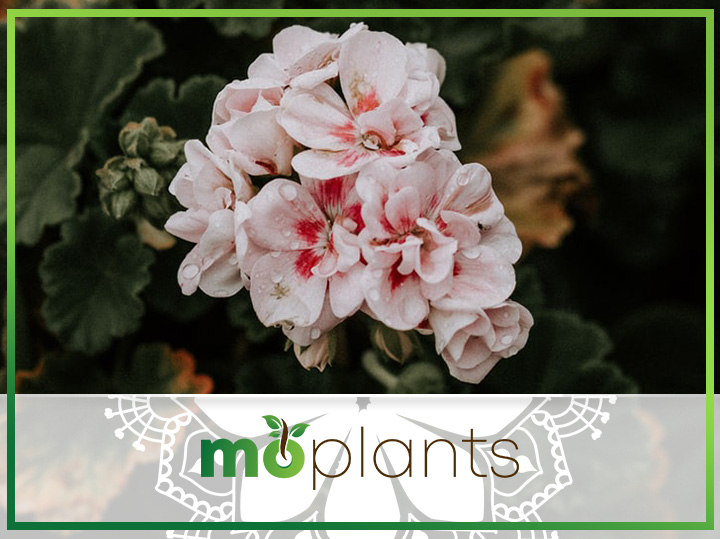Thanks to their enchanting beauty and exquisite fragrance, geranium flowers have always been a favorite among beginners and seasoned gardeners. These iconic bedding plants can brighten up their surroundings with their colorful blooms and vibrant foliage.
You can display these show-stopping flowers in hanging baskets adorning your terrace or add them to your outdoor garden to boost the curb appeal of your house. If traditional bedding displays are not your cup of tea, you can always grow these delightful plants in terracotta pots in your home.
Despite their breathtaking appearance, geraniums are not as dramatic as you may think. These plants are relatively easy to grow and don’t require any special treatment. As long as you provide them with adequate sunlight and water, they will continue to bloom and fill your space with their lovely scent.
If you are interested in growing geraniums but don’t know where to start, this handy guide is meant just for you. From planting their seeds to deadheading the plant, it will answer your most pressing questions about these popular garden flowers.
Introduction: Geranium
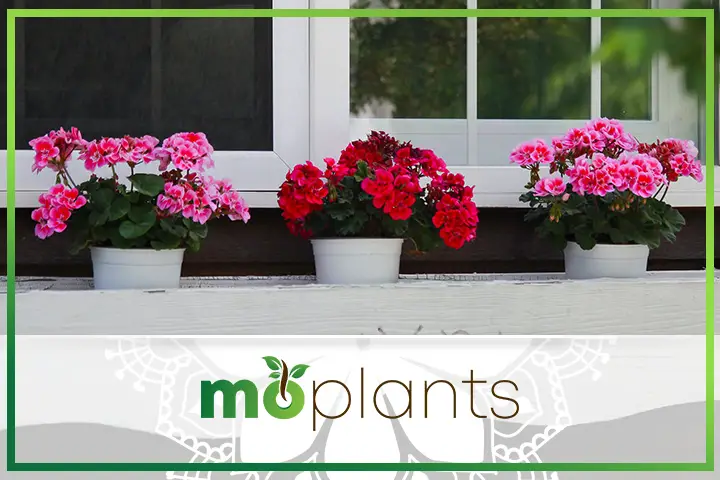
These lush green plants with a cluster of stunning pink, purple, red, orange, and white blooms are a common sight in gardens around the country. Interestingly, the flowering beauties we all know as geraniums are actually Pelargonium x hortorum – another genus of flowers that was mistakenly grouped with geraniums due to their uncanny resemblance to the hardy wild geraniums.
Although these plants are now grown in most parts of the world, they are native to South Africa. As the story goes, Dutch traders brought these attractive flowers to Europe in the early 1700s. Since hardy geranium was already popular in the region, Swedish botanist Carl Linnaeus classified this new variety of flowering plants under the genus Geranium in 1753.
However, due to their petals’ shape and the number of stamens, botanists reclassified the new geraniums under Pelargonium. They are also known as stork’s-bills due to their narrow and pointed seedpods. Meanwhile, true geraniums are called crane’s-bills.
In 1786, Thomas Jefferson brought the garden geraniums to North America from France. His plant cuttings soon multiplied as gardeners passed them on to their family and friends. By the early 1800s, geraniums had become a popular flowering plant in the country.
Today, geraniums are categorized into two main types: annual geraniums that belong to Pelargonium species and perennial geraniums that belong to the Geranium species. The cultivars of the former variety typically last only for a year and can be grown in most areas across the US. Meanwhile, the perennial plants usually return every season and do well in extremely warm areas.
These versatile plants can be grown both indoors and outdoors. Their size varies with each variety, with most plants growing up to 12 inches tall. However, you can also find geraniums that grow as tall as 48 inches. The average lifespan of these geraniums is nearly two years.
You can also plant these fascinating plants alongside lavender in your home garden.
How to Grow Geranium
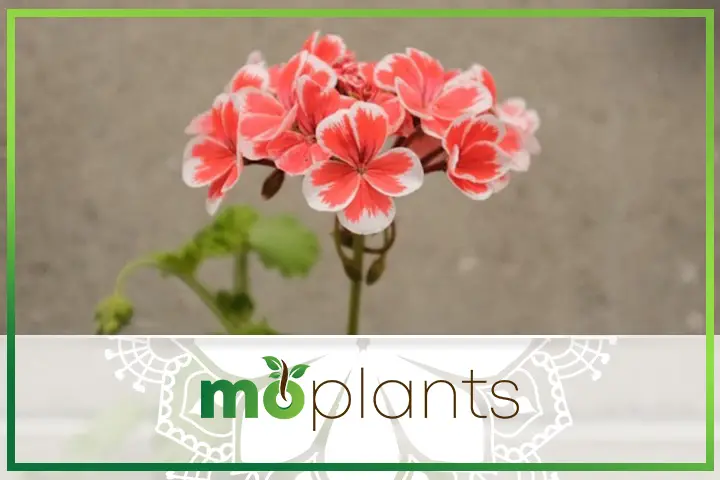
Here are some tips on how to grow geranium plants that all gardeners must know about.
Please note that this guide will focus on the garden or annual geraniums unless stated otherwise.
Planting and Placement
Since geraniums thrive in warm conditions, spring is the best time to plant these flowering beauties in your home garden. Please make sure the threat of frost has passed your region before starting the seeds, as these plants cannot tolerate extremely cold weather.
As for the placement, you can grow geranium flowers at any location that receives adequate sunlight. You can also place these plants in hanging baskets, flower beds, or terracotta containers.
Exposure to Sunlight
Geraniums love bright sunlight. Therefore, consider planting them in a location that would receive at least four to six hours of light every day. If the weather gets too hot, your geranium plants will surely appreciate partial shade.
However, if you put them in a relatively dark corner of your home or a place that doesn’t receive much sun, these plants will become leggy and won’t produce many flowers.
Watering Frequency
Though these annual flowering plants are drought-resistant, it is not a good idea to let them go without water for extended periods. Ideally, it would be best to allow the soil to dry out before watering geranium thoroughly.
During the winter months, you may want to reduce your watering frequency.
Potting Mix
You should consider choosing soil with a pH between 6.0 and 6.5 for growing geranium.
While almost any loose soil with organic matter is perfect for growing these plants, you can also add perlite or peat to ensure proper drainage and avoid root rot. Moreover, most experts recommend avoiding manure and vermiculite to grow these plants.
Infographic
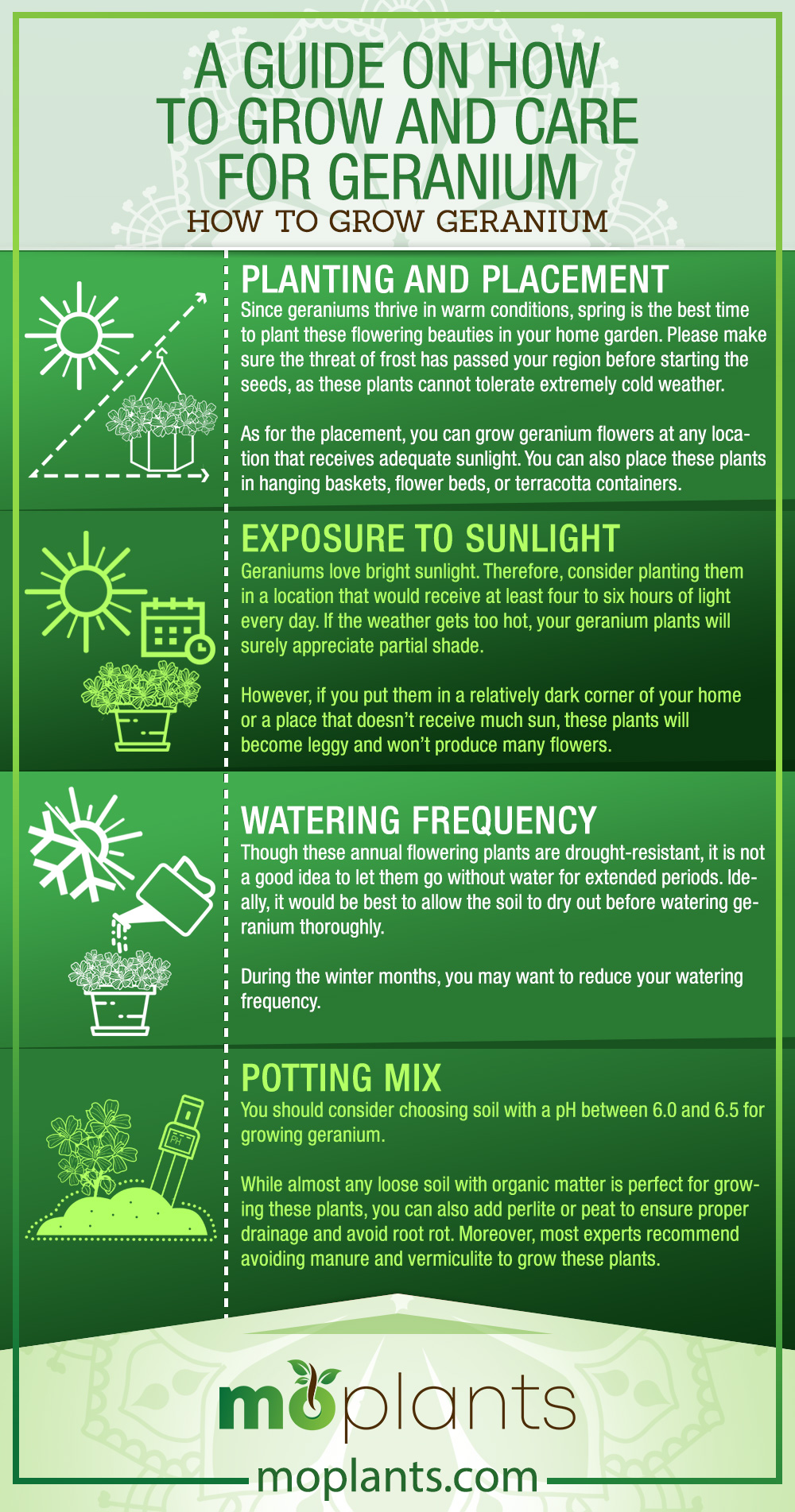
How to Grow Geranium from Seeds
Here is a step-by-step guide on how to grow geranium from seeds.
Step 1: Take a few small terracotta pots and fill them with moistened soil.
Step 2: Gently place one seed in each container and cover it with soil. Please make sure not to bury it too deep as it would need sunlight to germinate.
Step 3: Cover the containers with clear plastic wrap and move them to a warm location that receives bright, filtered light.
Step 4: Geranium seeds can take anywhere between three days to four weeks to germinate. Once you notice a green shoot sprouting from the soil, remove the plastic cover and spray the soil to moisten it.
Step 5: Move the young plants to a sunny spot. Typically, a south-facing window is the best choice to place these containers. You can also invest in bright lights to ensure your geraniums grow well. Moreover, the ideal temperature for these baby plants is around 70 degrees Fahrenheit during the day and about 60 degrees Fahrenheit at night.
Step 6: As soon as the plant produces three sets of leaves, consider transplanting it to a larger pot and feeding it a liquid fertilizer.
Step 7: If you plan to move your geraniums outdoors, it may be good to familiarize them with their new environment in short breaks. You can start by moving these plants to their new location for a few hours and then bring them back inside. Keep increasing their duration outdoors over the course of a week to ensure proper acclimation.
Geranium Care Tips
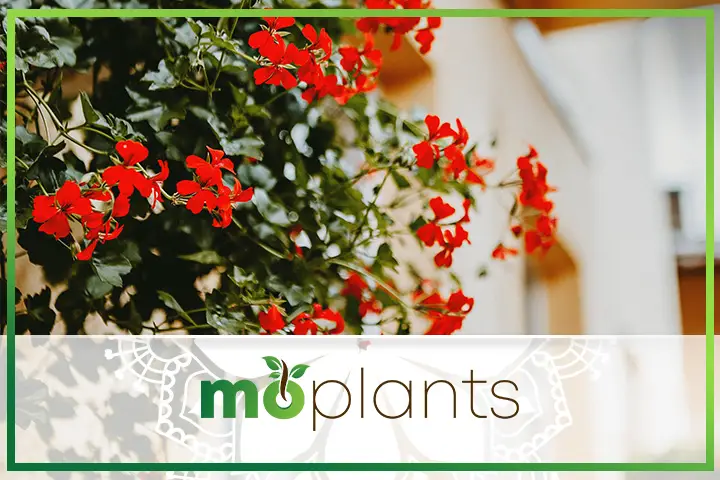
These geranium care tips will keep your beautiful flowering plants fresh and happy throughout the season.
Temperature
Geraniums prefer warm temperatures ranging between 65 to 85 degrees Fahrenheit during the spring and summer months. If the temperature gets higher, you may want to bring your plants indoors or move them to a partially shaded location.
During the winter months, these plants can survive temperatures as low as 40 to 50 degrees Fahrenheit.
Deadheading
Garden geraniums require regular deadheading. This practice not only encourages new growth but also plays a vital role in preventing various diseases.
To deadhead your geranium plant, pinch back the flower stalk once the flower dies. It would also be best to remove dead leaves from the plant so the healthy foliage can receive proper nutrition. Moreover, you can make your plant look bushier by pinching its growing points.
This is easily one of the most vital geranium care tips that you should know about.
Fertilizing
While geranium plants are not heavy feeders, their flowers and foliage will thank you for light fertilization during the growing season. You can either invest in a specialty geranium fertilizer for your plants or create your own by mixing two tablespoons of 20-20-20 fertilizer into a gallon of plain water. This solution will keep geraniums fed for three to four weeks.
Infographic
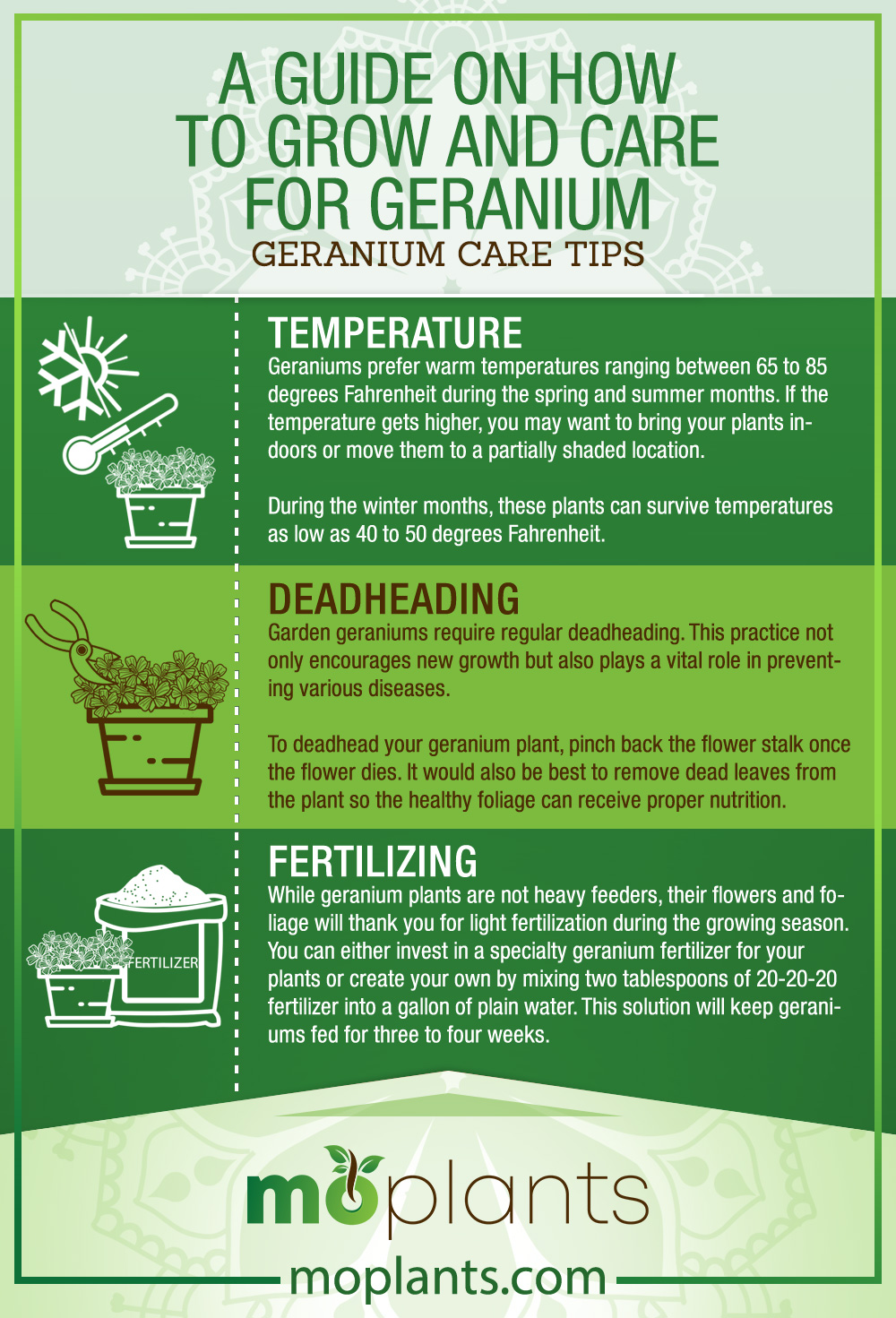
Common Geranium Problems and How to Solve Them
These are some of the most common issues you may face while growing geranium flowers in your home. To help you out, we have also discussed some tips on how to troubleshoot these problems.
Shedding Leaves
Over and underwatering can both cause your geranium plant to lose its foliage. The best way to treat this problem is to determine whether your plant receives too much or too little water.
To test this, consider inserting your fingers into the soil to check if the top layer is moist. If you can feel wetness on your fingers, consider holding off on watering and moving your plant to a warm and sunny location. Alternatively, if the soil feels completely dry, please water your plant thoroughly. Also, make sure to discard the excess water that may have accumulated in the saucer placed underneath the pot.
Plant Not Blooming
Your geranium is likely not blooming because it is receiving too little light or too much fertilizer (or both). While these flowering beauties can grow in shaded locations, they usually don’t produce many flowers under such conditions.
On the other hand, if you are feeding your geranium frequently, consider holding off for a few weeks to see if the plant starts producing new flowers.
Common Pests and Diseases
Geranium can be vulnerable to aphids, cabbage loopers, scales, cankerworms, and slugs, among other common pests. Usually, washing the plant with insecticidal soap is enough to get rid of these bugs and revive the foliage.
Furthermore, some geranium varieties can be prone to fungal infections during the rainy season. You can use commercial fungicides to treat this common issue.
Popular Types of Geranium
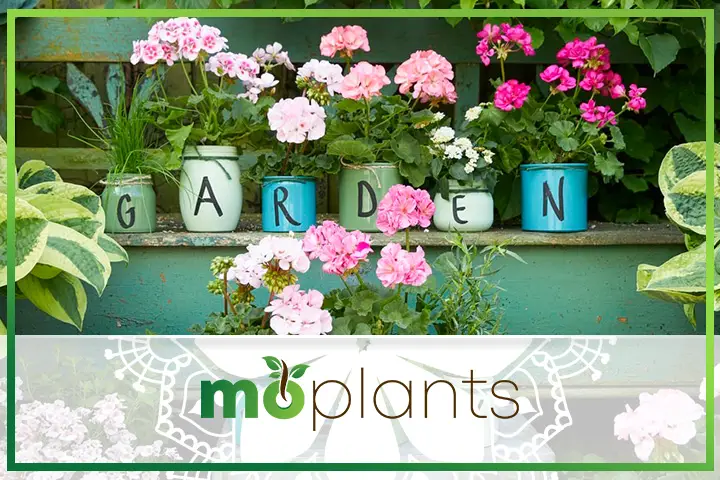
Did you know the annual geranium has nearly 300 species? These charming plants can produce an astonishing range of flowers with varying scents.
The most popular types of geranium include:
Zonal Geraniums
These types of geranium plants produce single or double blooms that are white, pink, red, yellow, orange, purple or burgundy in colors. This variety can tolerate high temperatures and grow well in dry conditions.
Some of the most well-known cultivars of zonal geraniums include Tango, Classic, and Rocky Mountain.
Regal Geraniums
More commonly referred to as Marsha Washington geraniums, these regal-looking plants are known for their multicolored flowers. The blooms are relatively large yet delicate, requiring proper attention to thrive and grow.
Blue Orchid, Ace High, and Brown’s Butterfly are among the most popular cultivars of regal geraniums.
Scented Geraniums
As the name suggests, these geranium plants are known for their scented foliage. This variety of flowering plants does not bloom as prolifically as others, but they remain a top choice among gardeners due to their mesmerizing fragrance.
Some of the most famous cultivars of scented geraniums include Lemon Balm, Ginger, and Chocolate Mint.
Ivy Geraniums
Last but not least, ivy geraniums are the most ornamental types of geranium, featuring lustrous foliage paired with single or double blooms. These plants are perfect for hanging from hanging baskets or in traditional flower beds cascading over the walls of your house.
Summer Showers and White Mesh are two of the most renowned cultivars of ivy geranium.
Geranium FAQs
Let’s look at some of the most frequently asked questions about geranium flowers.
How to keep geraniums blooming?
The best way to ensure your geranium plant produces brilliant flowers is to provide it with proper light and keep the soil moist at all times. However, please make sure you are not overwatering the plant, as it may result in root rot.
Why do the leaves on the geranium plant turn yellow?
Overwatering is one of the most common reasons the leaves on geranium plants begin turning yellow. To counter this problem, check the soil’s moisture level and move your container to a warm and sunny location.
When do geraniums bloom?
Luckily, garden geraniums tend to flower freely throughout the growing season.
To summarize, annual geraniums or Pelargoniums are among the best flowering plants to grow indoors and outdoors. You can easily grow these eye-catching beauties from seeds and display them in terracotta pots, hanging baskets, or traditional flower beds.
Moreover, geraniums do not require special attention. They will continue to flower and fill your home garden with their sweet fragrance for months, making them the real star of your plant collection.

